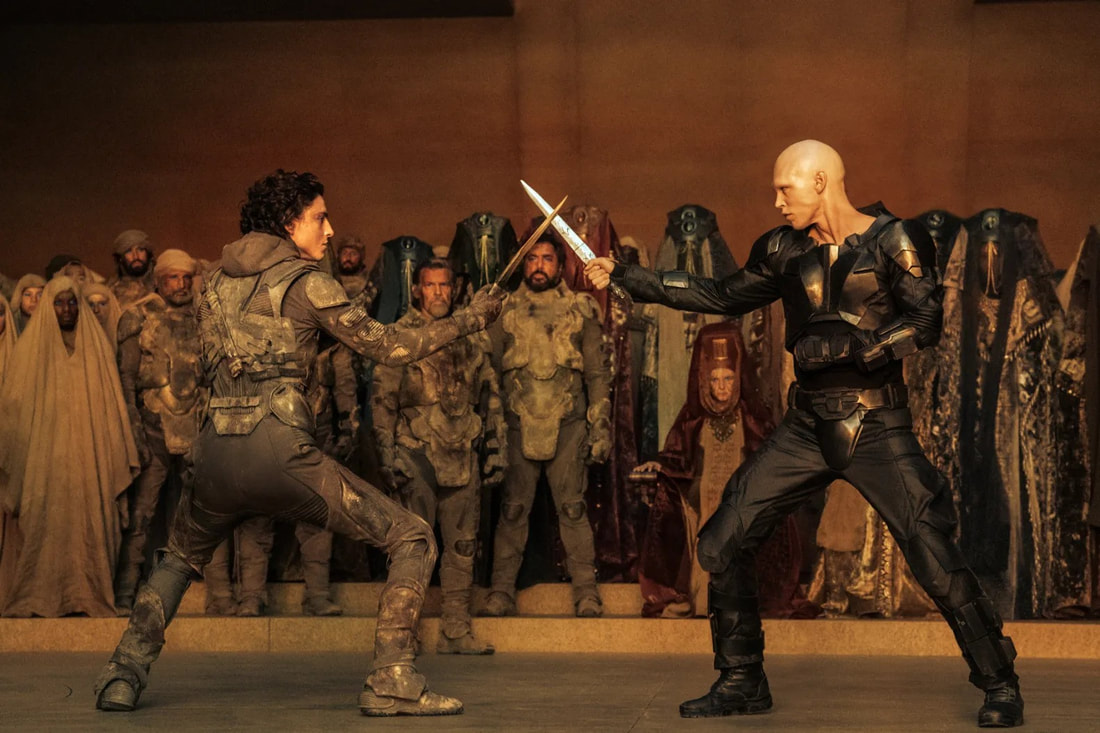|
Image c/o NIKO TAVERNISE/WARNER BROS By Matthew Colvin Entertainment Columnist After a two and a half-year long wait that was nearly as torturous as the pain box lead protagonist Paul Atreides’ (Timothée Chalamet) hand was forced into in the first Dune film, writer/director Denis Villeneuve’s massive, ambitious and oh-so-sandy sequel has arrived. It is bigger, weirder, and more spectacular than the first film in almost every way. Put simply, Dune: Part Two is the sort of film that reminds you exactly why some movies are meant to be seen on the big screen.
Dune: Part Two picks up almost immediately after the ending of Part One, and it doesn’t waste time recapping or expositing what has already occurred on the desert planet of Arrakis. As such, the first film is effectively mandatory viewing if you want to understand the complex plotting and worldbuilding on display here fully. Paul and his mother Jessica (Rebecca Ferguson) have formed an uneasy truce with Chani (Zendaya), Stilgar (Javier Bardem), and the rest of the Fremen natives of Arrakis as they continue to flee the brutal soldiers of House Harkonnen who seek to snuff them out, ending the bloodline of House Atreides. The sequel feels a deal more fast-paced than its predecessor; Part One concerned itself greatly with set-up, spending much of its runtime on slow-burn worldbuilding and sowing seeds for later plot developments. Many elements that were introduced but not fully realized before are brought to the forefront now, from the Bene Gesserit’s insidious scheming to Paul’s mysterious visions, and since the audience is already familiar with these story threads, Part Two doesn’t have to waste any time before getting straight into the action. On the topic of action, the intense battle sequences between the Fremen and the Harkonnens, ranging from grand battles on fields of sand to intimate, intense duels, are utterly spectacular and account for many of the film’s most visually dazzling moments. As the story plays out, Paul finds himself ascending in the ranks of the Fremen in the name of claiming his role as ‘Lisan al Gaib’, a Messianic figure for the Fremen, while seemingly slowly losing his morals in the process. The central story is effective, largely due to the inherent tragedy it includes; Paul is a good person fighting for the right things, but the power of blind fanaticism overrides his original motivation and turns him into someone almost unrecognizable from who he was at the start of the film. The narrative at the core is powerful, but what truly makes this film astonishing to behold is the craft on display. The use of color, combined with Greig Fraser’s incredible cinematography, keeps the movie consistently beautiful from start to finish. One particularly striking sequence is set on the Harkonnen homeworld, which is so devoid of color that the whole scene looks as if it’s been shot in black and white. Fraser’s team shot the entire sequence with a modified infrared camera, and the footage was converted to monochrome in post, creating an incredibly striking, eerie visual feel. It is this brand of creativity that pervades the entire feature, and those moments of brilliant imagery will stick with viewers long after the credits roll. The sound design is incredibly immersive, made to be experienced in larger theater speakers; and when mixed with Hans Zimmer’s heated, often heart-pounding score, it becomes nearly unmatched. The performances are solid across the board, with a handful of standouts. Chalamet sells Paul’s entire arc over the course of the film exceptionally well, but Rebecca Ferguson’s performance as his zealous mother guiding his political and religious ascension is so gripping that it nearly overshadows him. It is a massive upgrade from her largely underwhelming presence in the first film. Likewise, Austin Butler shines as the new character Feyd-Rautha, an antagonist who would run the risk of being almost cartoonishly evil if it weren’t for how much sheer energy and fun he injects into the role. Dune: Part Two proves that science fiction can thrive just as well as any other genre in the film industry with competent direction and a passionate, skilled team (and the generous $190 million budget probably didn’t hurt either). So hop on your sandworm, get over to a theater, and see this one on the biggest screen you can before it goes streaming, because this film is as cinematic as they come. As it was written.
0 Comments
Leave a Reply. |
STAFFMadison Sciba '24, Archives
October 2023
Categories |


 RSS Feed
RSS Feed